目录
精确率与召回率
混淆矩阵:
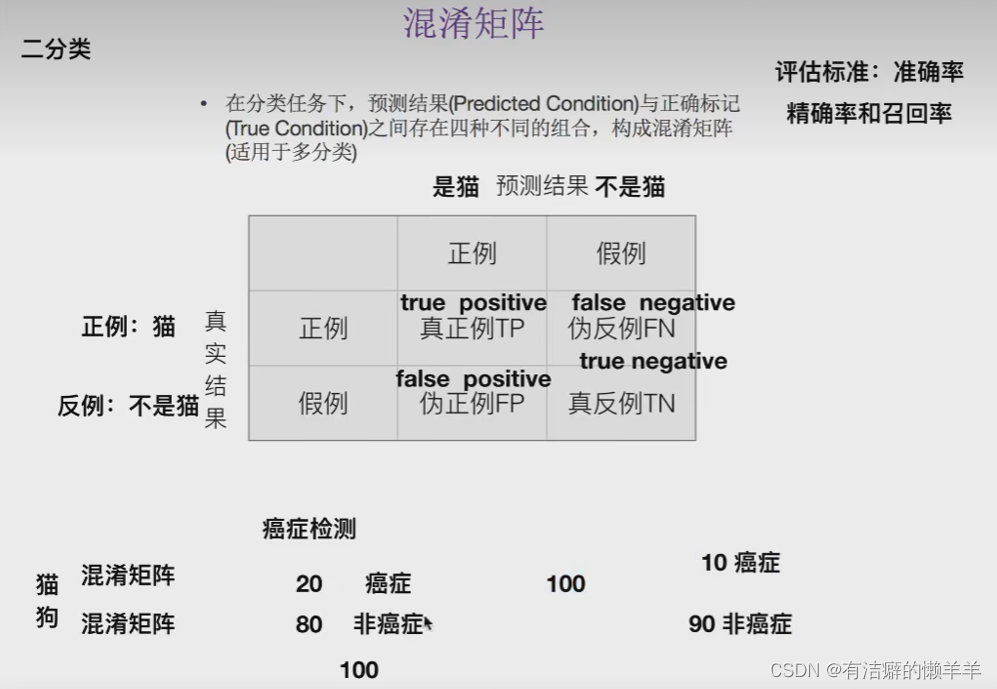
精确率和召回率:

其他分类标准,F1-score,反映了模型的稳健性

分类模型评估:
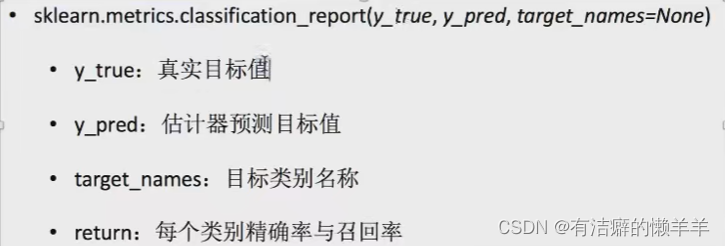
模型的选择和调优
交叉验证
交叉验证:为了让被评估的模型更加准确可信
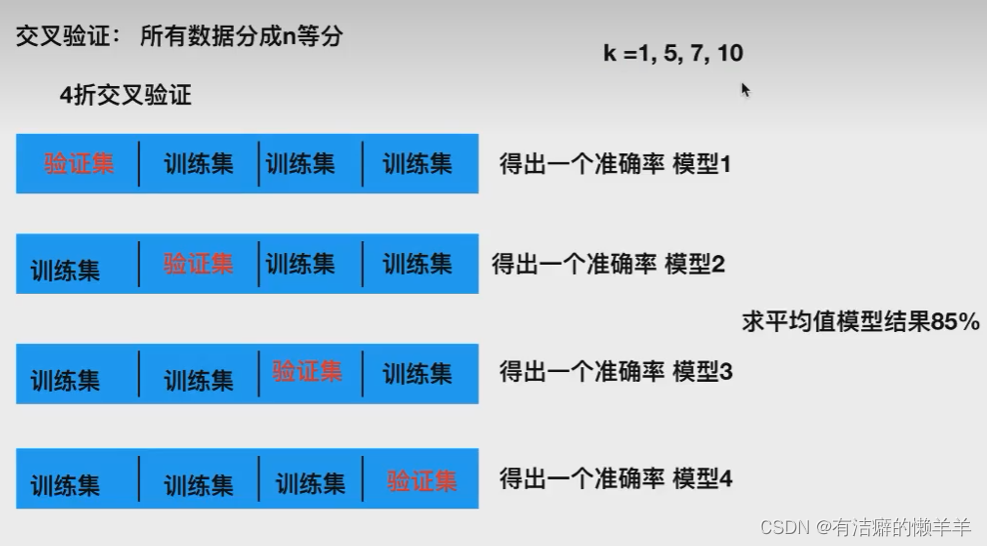
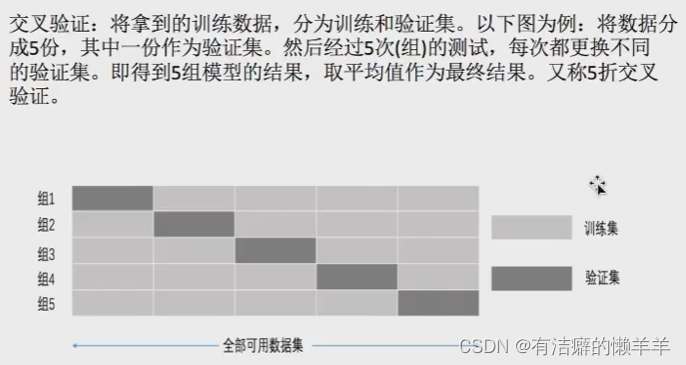
网格搜索-超参数搜索
网格搜索:调参数 K-近邻:超参数K
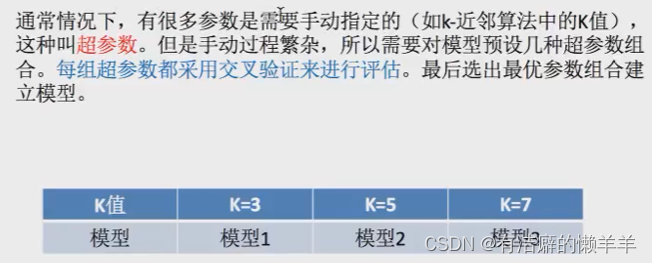
超参数搜索-网格搜索API
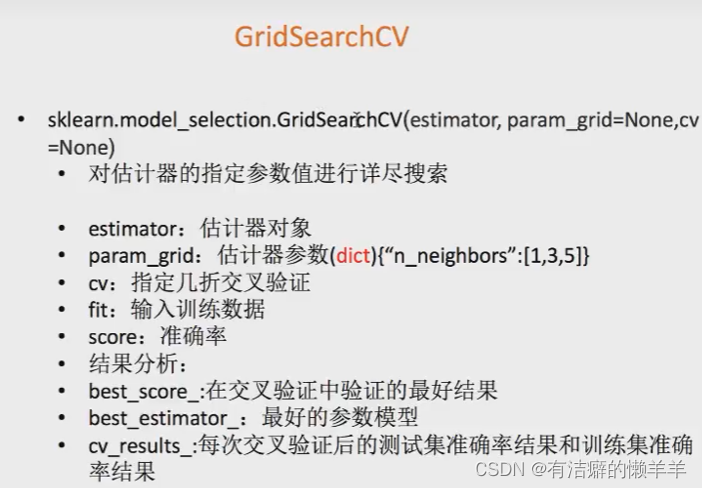
from sklearn.metrics import classification_report
from sklearn.model_selection import train_test_split,GridSearchCV
from sklearn.neighbors import KNeighborsClassifier
from sklearn.preprocessing import StandardScaler
import pandas as pd
def knncls():
"""K-近邻预测用户签到位置"""
# 读取数据
data = pd.read_csv("./data/FBlocation/tain.csv")
print(data.head(10))
# 处理数据
# 1.缩小数据
data.query("x > 1.0 & x < 1.25 & y > 2.5 & y < 2.75")
# 处理时间的数据
time_value = pd.to_datetime(data['time'],unit='s')
print(time_value)
# 把日期格式转换成字典格式
time_value = pd.DatetimeIndex(time_value)
# 构造一些特征
data['day'] = time_value.day
data['hour'] = time_value.hour
data['weekday'] = time_value.weekday
# 把时间戳特征删除
data = data.drop(['time', axis=1)
# 把签到数量少于N个目标位置删除
place_count = data.groupby('place_id').count()
tf = place_count[place_count.row_id > 3].reset_index()
data = data[data['place_id'].isin(tf.place_id)]
# 取出数据当中的特征值和目标值
y = data['place_id']
x = data.drop(['place_id'],axis=1)
# 进行数据的分割训练集和测试集
x_train,x_test, y_train, y_test = train_test_split(x,y,test_size=0.25)
# 特征工程(标准化)
std = StandardScaler()
# 对测试集和训练集的特征值进行标准化
x_train = std.fit_transform(x_train)
x_test = std.transform(x_test)
# 进行算法流程 # 超参数
knn = KNeighborsClassifier()
## fit, predict,score
# knn.fit(x_train, y_train)
## 得出预测结果
#y_predict = knn.predict(x_test)
#print("预测的目标签到位置为:", y_predict)
## 得出准确率
#print("预测的准确率:", knn.score(x_test,y_test))
# 构造一些参数的值进行搜索
params = {"n_neighbors":[3,5,10]}
# 进行网格搜索
gc = GridSearchCV(knn, param_grid=param, cv=10)
gc.fit(x_train, y_train)
# 预测准确率
print("在测试集上准确率:",gc.score(x_test, y_test))
print("在交叉验证当中最好的结果:", gc.best_score_)
print("选择最好的模型是:", gc.best_estimator_)
print("每个超参数每次交叉验证的结果:", gc.cv_results_)
return None
if _name_ == "_main_":
knncls()








 文章介绍了精确率与召回率在评估分类模型中的作用,以及如何使用混淆矩阵来理解模型性能。接着,文章探讨了交叉验证作为模型选择和调优的一种方法,并详细阐述了网格搜索在超参数调优中的应用,以K-近邻模型为例展示了如何进行参数搜索。此外,还涉及了数据预处理步骤,如时间戳转换和特征工程。
文章介绍了精确率与召回率在评估分类模型中的作用,以及如何使用混淆矩阵来理解模型性能。接着,文章探讨了交叉验证作为模型选择和调优的一种方法,并详细阐述了网格搜索在超参数调优中的应用,以K-近邻模型为例展示了如何进行参数搜索。此外,还涉及了数据预处理步骤,如时间戳转换和特征工程。
















 3758
3758

 被折叠的 条评论
为什么被折叠?
被折叠的 条评论
为什么被折叠?








